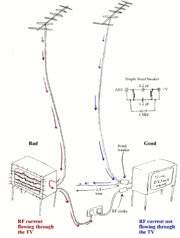
Braid-breaker
Encyclopedia

Television interference
Television interference is a particular case of electromagnetic interference which affects television reception. Many natural and man-made phenomena can disrupt the reception of television signals...
(TVI). In many cases of TVI, caused by a high field strength of a nearby high frequency
High frequency
High frequency radio frequencies are between 3 and 30 MHz. Also known as the decameter band or decameter wave as the wavelengths range from one to ten decameters . Frequencies immediately below HF are denoted Medium-frequency , and the next higher frequencies are known as Very high frequency...
(HF) transmitter, the aerial down lead plugged into the back of the TV acts as a longwire antenna or as a simple vertical element. The radio frequency
Radio frequency
Radio frequency is a rate of oscillation in the range of about 3 kHz to 300 GHz, which corresponds to the frequency of radio waves, and the alternating currents which carry radio signals...
(RF) current flowing through the tuner of the TV tends to generate harmonics which then spoil the viewing.
The braid breaker works by preventing RF signals picked up on the outside (common mode signals) flowing into the TV set, while passing RF inside the coax (non common mode) from the antenna.
Designs
One design is a snap-on ferriteFerrite (magnet)
Ferrites are chemical compounds consisting of ceramic materials with iron oxide as their principal component. Many of them are magnetic materials and they are used to make permanent magnets, ferrite cores for transformers, and in various other applications.Many ferrites are spinels with the...
choke
Choke (electronics)
A choke is a coil of insulated wire, often wound on a magnetic core, used as a passive inductor which blocks higher-frequency alternating current in an electrical circuit while passing signals of much lower frequency and direct current by having an impedance largely determined by reactance, which...
, plugged into the aerial cable just before it plugs into the TV set.
Another option is to use a combined braid breaker and hi-pass filter. One simple design consists of two 4.7 pF ceramic capacitors and two simple coils (4 turns of 20 gauge copper
Copper
Copper is a chemical element with the symbol Cu and atomic number 29. It is a ductile metal with very high thermal and electrical conductivity. Pure copper is soft and malleable; an exposed surface has a reddish-orange tarnish...
wire 6 mm long wound on a 6 mm drill bit {air cored}). The design is a symmetric network: the coils are connected from the braid to the core of the coaxial cables, while one of the capacitor
Capacitor
A capacitor is a passive two-terminal electrical component used to store energy in an electric field. The forms of practical capacitors vary widely, but all contain at least two electrical conductors separated by a dielectric ; for example, one common construction consists of metal foils separated...
s is connected between the core of the input and the core of the output cable. The other capacitor is connected between the braids of the input and output leads respectively. Finally, a 1.5 MΩ resistor is wired in parallel with one of the capacitor; the purpose of this resistor
Resistor
A linear resistor is a linear, passive two-terminal electrical component that implements electrical resistance as a circuit element.The current through a resistor is in direct proportion to the voltage across the resistor's terminals. Thus, the ratio of the voltage applied across a resistor's...
is to prevent the buildup of static electricity
Static electricity
Static electricity refers to the build-up of electric charge on the surface of objects. The static charges remain on an object until they either bleed off to ground or are quickly neutralized by a discharge. Static electricity can be contrasted with current electricity, which can be delivered...
on the TV aerial.
The reactance of the capacitors is very large for signals between 1 and 50 MHz, but for UHF
Ultra high frequency
Ultra-High Frequency designates the ITU Radio frequency range of electromagnetic waves between 300 MHz and 3 GHz , also known as the decimetre band or decimetre wave as the wavelengths range from one to ten decimetres...
TV signals (>450 MHz) it is very small. Also, the reactance of the coils at the lower frequencies is very small, while for the wanted UHF signals the coils have a very high impedance. The network does the following:
- At HF (1 to circa 50 MHz) it shorts the core to the braid at both the input and the output. Also it isolates the input from the output.
- At UHF it has no path between the core and the braid for either the input or the output, while the core and the braid are connected as normal to the respective terminals on the other side of the network.

